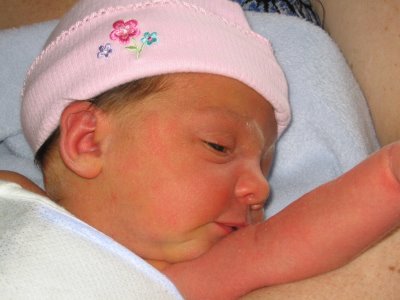Bilirubin is a yellowish pigment found in stool and blood. High levels of bilirubin in your blood will make your skin look pale and the whites of your eyes turn yellow. The condition is called jaundice. The old blood cells break down, which is completely normal, and leave behind a yellow pigment called bilirubin. It travels to your liver and then goes into the bile duct. It stays in gall bladder from where it enters small intestine as bile to digest fats. The excess bilirubin is excreted with your stool.
What Are the Normal Bilirubin Levels in Newborns?
 Normal bilirubin levels are usually under 5mg/dL, but most newborns have it above 5mg/dL and have some kind of jaundice at birth. It happens because the blood breaks down in the same way in newborns as in adults, but newborns have relatively immature pathways of the liver. Their inability to get rid of excess bilirubin results in jaundice.
Normal bilirubin levels are usually under 5mg/dL, but most newborns have it above 5mg/dL and have some kind of jaundice at birth. It happens because the blood breaks down in the same way in newborns as in adults, but newborns have relatively immature pathways of the liver. Their inability to get rid of excess bilirubin results in jaundice.
How to Test Bilirubin Levels in Newborns
If you suspect your baby has jaundice, you will have to take him/her for a blood test. The test involves using a device called a bilirubinometer that throws light on your baby's skin to calculate the level of bilirubin. It analyzes how the skin absorbs the light. A blood test is also an option that involves pricking your baby's heel with a needle to take a sample.
A bilirubinometer is a safer option to check jaundice in babies. They may require a blood test if they develop jaundice within the first 24 hours of birth. Your doctor will then compare the findings with normal bilirubin levels in newborns to decide if any treatment is necessary.
Is Newborn Jaundice Harmful?
Newborn jaundice is usually not harmful in most cases because it is only physiologic jaundice. This happens because a baby's organs are not fully developed yet. This type of jaundice usually becomes worse until the third or fourth day of birth, but it will go away in a week or so.
Sometimes, jaundice does not get better in a couple of weeks and the levels of bilirubin keep increasing. The condition is called kernicterus and it can damage the brain. It responds well to treatment though.
Other factors may also cause jaundice in children such as a problem with digestive system or an infection. Any mismatch of mom's blood with baby's blood (Rh incompatibility) may also cause jaundice.
Here is a bit more about when newborns with jaundice may need some treatment.
|
Levels of Bilirubin |
Age |
|---|---|
|
10 mg or higher |
Less than 24 hours old |
|
15 mg or higher |
Between 24 and 48 hours |
|
18 mg or higher |
Between 49 and 72 hours |
|
20 mg or higher |
Older than 72 hours |
How to Help Recover Normal Bilirubin Levels in Newborns?
Your baby will need treatment if the bilirubin level is above the normal range for newborns. He or she will be put under a type of fluorescent light to treat the jaundice. This is called phototherapy. The skin absorbs the light, which changes the bilirubin so that the body can more easily get rid of it. The treatment is usually done in a hospital. But babies sometimes are treated at home.
How Can You Help Your Baby?
You need to keep a few things in mind to help your baby with jaundice. For instance, check the color of your baby's skin twice a day to ensure it is returning to normal. Check your baby's eyes to make sure the white part of the eyes is becoming normal. Contact your doctor immediately if you feel that the yellow color is getting brighter after your baby is 3 days old.
What's more, you should feed your baby at least 8-10 times a day – that is when you are breastfeeding. The more your baby eats, the easier it is for him/her to get rid of excess bilirubin. You should stick to 6-10 feedings a day if you are feeding from a bottle.
Can Jaundice Be Prevented in Newborns?
Some degree of jaundice is usually normal in newborns and it is not possible to prevent. Feeding your baby properly is the best way to keep things from becoming worse. Moreover, pregnant women should get blood tests done to identify unusual antibodies. It is important to carefully monitor your baby for the first week or so to prevent further complications.
